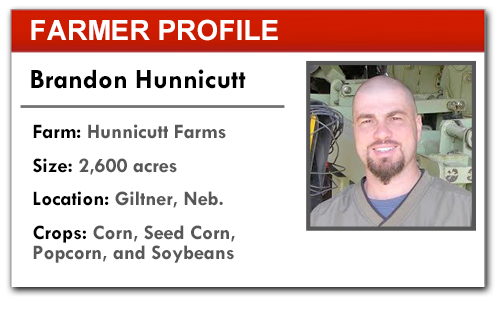 The Hunnicutts are no strangers to precision farming. For more than 10 years, they have been pushing the envelope, using first their own RTK base station and now a signal subscription to precisely strip-till, then plant, spray and harvest their 2,600 acres of corn, seed corn, popcorn and soybeans.
The Hunnicutts are no strangers to precision farming. For more than 10 years, they have been pushing the envelope, using first their own RTK base station and now a signal subscription to precisely strip-till, then plant, spray and harvest their 2,600 acres of corn, seed corn, popcorn and soybeans.
Brandon, who farms with his father, Daryl, and brother, Zach, near Giltner, Neb., have been involved with a variety of field trials with the Univ. of Nebraska-Lincoln as well as Pioneer and others over the years.
“We run almost all John Deere equipment. Our two 24-row planters have been upgraded with Precision Planting seed meters and AirForce downpressure units,” explains Brandon. One planter, used exclusively for seed and field corn planting, is also equipped with WaveVision sensors for even greater population control and monitoring.
“We start with a strip-till pass in the fall or the spring, depending on the year and the field,” Brandon says. “That pass is auto-steered by the GreenStar 2630 monitor. We have four 2630 units, one for each of the planter tractors, one in a tractor that can do additional fieldwork, and one in our Deere 4830 sprayer with a 90 foot boom. We pull one unit out and put it in the combine for harvest.”
Dry fertilizer is custom-applied, with the rate varying some because they base the application rate on grid sample results, which are rather consistent across their fields. However, Brandon says they are working with Pioneer on getting Encirca farm management services operational to develop prescription rates for fertility and population.
The Hunnicutts have installed Ag Leader OptRx crop sensors on their sprayer to fine-tune nitrogen applications, and Brandon sees great potential with the technology. One university plot trial using the system recommended applying one third the normal rate of nitrogen that they normally apply.
What Farmers Want From You is a series of farmer profiles that examine the scope of precision farming tools individual farmers are using on their operation, along with the frustrations that can occur with adopting new technology and how dealers can alleviate those "points of pain" for farm customers. For the latest additions to the series, visit our What Farmers Want From You feed.
If the data shows a positive economic effect on yield, using dramatically lower rates of nitrogen across the farm could save as much as $200,000 in fertilizer cost, Brandon says. However, he recalls some issues getting the 2630 and the Ag Leader monitor to talk in the sprayer cab.
The GS2630 controls the steering and records the applied rates, while the other monitor interprets data from the sensors. “We had to find a specific person within the Deere organization who could give us the activation code so the Ag Leader monitor could talk with the GreenStar system,” Brandon says. “Hardly anyone runs an all-green or all-red system. They must be able to exchange information more easily.”
Point of Pain: Keeping My Data Secure
Brandon says sharing precision data can be difficult. Deere’s Apex system is the most challenging, he says. With others, it’s easier to identify fields and pull out data, but that’s not so with Apex.
Brandon also is concerned about their farm data getting shared with others without their permission. Although the Hunnicutts embrace the ability to collect and share data in the spirit of furthering crop research with universities and even private companies, they also are a bit skeptical about how the data could be used by others with data access.
“Some of the new R-Series Deere tractors have some great data sharing capabilities, but what is it going to take to make sure that data doesn’t get shared with entities we don’t want to share it with?,” he says. “We are thinking about using a code name for varieties or other variables in our system that will make it more difficult for others to know which hybrids we are using. I hope precision farming dealers will be able to help us protect our data.”



![[Technology Corner] Discussing AI’s Potential Impact on Service & Support](https://www.precisionfarmingdealer.com/ext/resources/2025/04/11/Discussing-AIs-Potential-Impact-on-Service--Support.png?height=290&t=1744385717&width=400)


